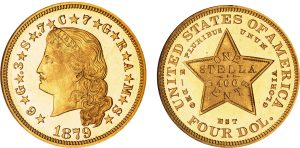Collecting American coins: Caring for your collection
Part II
Image: 1879 $4 Stella Flowing Hair Cameo PF-67 NGC coin. Courtesy of Bonhams.
Coins are an enticing hybrid of historical artefact and design object. Whichever lens one chooses to look through in their appreciation of these numismatic items, an enthusiast should be singularly focused on caring for their collection.
In addition to the usual concerns of rarity and market-demand, material is also a key component of coin values. Traditionally, coins have been made from three metals—gold, silver and copper—and their alloys.1 Here, historical anecdotes and knowledge illuminate interesting foibles in the history of American coin production. Collecting coins is a natural for history buffs and detectives alike!
Like territory coinage, explained in Part I: History and essentials, of this series, pattern coinage is another important collectible type. Pattern coinage are experimental designs produced by the US Mint which needed Congressional approval before entering circulation in the United States.
Collectible Stellas
A rare example of pattern coinage are a series of $4 pattern gold coins produced in the 1870s. The coins, which featured the head of Liberty on one side and a star on the reverse—were meant to be a new base unit for gold coins. Made with a set amount of gold, the currency was intended to be an international coin convertible in other countries based on its gold content.2

1879 $4 Stella Flowing Hair Cameo PF-67 NGC coin. Courtesy of Bonhams.
With roughly $4 worth of gold in each piece, these coins have a nice weight, not to mention a notable name. In an early example of marketing, the planners decided to name the pattern “Stella,” meaning star in Latin. Many “gold stars” were given to lawmakers and congressman as gifts to build support for the coinage. Ultimately, the Stellas were never produced. Most were melted down, except for occasional pieces that were kept or bartered for other services.3
If you were lucky enough to have a Stella coin, it would be made of gold, right? Not necessarily, as Paul Song, Director of Coins for Bonhams, recalls, “A few years back, I received a blurry iPhone image from a gentleman who had purchased some reproduction $4 gold coins at a garage sale in the 1970’s, and wanted to know if they had any value. When I saw the coins in person, my initial hesitations were confirmed: the coins weighed about half of what a genuine $4 gold Stella should weigh, and the color of coins suggested they were only gold-plated, not 90% pure gold as all genuine coinage.
However when I looked further at the coins, I had an odd feeling that I wasn’t sure. After further research, I discovered these coins were copper versions of the coinage with gilt surfaces. All in all, the gentleman’s two coins, which his father paid less than $20 for in the 1970’s, realized almost $70,000 each!”
Original gold Stella coins fetch even more. In 2013, a 1979 $4 Stella flowing hair cameo coin sold for $280,800 at auction.2
This colorful anecdote is just one of many fascinating stories in the history of American coinage.
Caring for your coin collection
Whether you have gold dollars or copper pennies in your collection, how can you best take care of your precious metal coins?
It can be easy to think that coins are difficult to damage, as most of us walk around with them in our wallets, purses and pockets every day. But if you empty your coin purse and look closely, you will notice coins have a wide variety of conditions.
Metals react to atmospheric pollutants as well as liquids, so it is important to keep coins in a dry atmosphere, preferably in acid-free materials.
There are many options for storing coins, among the most popular are:
- Envelopes (paper should be PH-neutral)
- Albums (plastic should not contain PVC)
- Display cases
Display options can range from boxes to cabinets and frames that make the recto and verso side of the coin visible. Numerous options and advice exist online.
Some plastics—such as PVC—emit fumes that can cause erosion on the coins. Instead, if choosing a plastic display or holder, select ones made of polythene and polyester, which are better for the coin.
Of course, keep any documentation, certificates of authenticity, or grading certificates. The US Mint offers further advice on storing your collection here.
In addition, coin enthusiasts can further educate themselves by joining professional associations such as the American Numismatic Association, or local coin clubs.
Insuring your coin collection
Like other valuable collectibles, a coin collection can be insured to help protect your valuables in the event of covered loss or damage that might decrease their value. Documentation helps prove authenticity, and is also helpful in the event of a claim to establish market replacement value.
Collectors may choose a blanket policy with a maximum value limit per coin. They may also choose to schedule coins of significant value individually. Some collectors opt to schedule higher value coins, and keep modestly priced coins under a blanket policy.
Ask your independent insurance broker or your insurance provider’s art and collectibles specialist about the best options for your specific collection.
Insurance helps collectors have peace of mind. That means you have more time to pursue the adventure of learning more about a young nation’s history told through coins.
To learn more about Berkley One’s collectibles coverage, visit us here.
For more stories and to learn the basics of collectible American coins, check out the first article in this series, Part I: History and essentials.
Katja Zigerlig is Vice President of Art, Wine + Collectibles Advisory at Berkley One (a Berkley Company).



